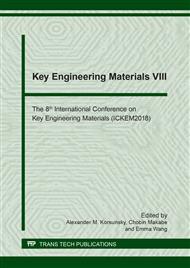[1]
V. C. Li, S. Wang and C. Wu, Tensile strain-hardening behaviour of polyvinyl alcohol engineered cementitious composite (PVA-ECC), Materials Journal. 98 (2001) 483-492.
DOI: 10.14359/10851
Google Scholar
[2]
V. C. Li, On engineered cementitious composites (ECC) a review of the material and its applications, Journal of Advanced Concrete Technology. 1 (2003) 215-230.
DOI: 10.3151/jact.1.215
Google Scholar
[3]
G. Parra-Montesinos and J. K. Wight, Seismic response of exterior RC column-to-steel beam connections, Journal of structural engineering. 126 (2000) 1113-1121.
DOI: 10.1061/(asce)0733-9445(2000)126:10(1113)
Google Scholar
[4]
G. Parra-Montesinos, High-performance fiber-reinforced cement composites: an alternative for seismic design of structures, ACI Structural Journal. 102 (2005) 668.
DOI: 10.14359/14662
Google Scholar
[5]
S. Qudah, and M. Maalej, Application of engineered cementitious composites (ECC) in interior beam–column connections for enhanced seismic resistance, Engineering Structures. 69 (2014) 235-245.
DOI: 10.1016/j.engstruct.2014.03.026
Google Scholar
[6]
S. H. Said and H. A. Razak, Structural behaviour of RC engineered cementitious composite (ECC) exterior beam–column joints under reversed cyclic loading, Construction and Building Materials. 107 (2016) 226-234.
DOI: 10.1016/j.conbuildmat.2016.01.001
Google Scholar
[7]
F. Yuan, J. Pan, Z. Xu, and C. K. Y. Leung, A comparison of engineered cementitious composites versus normal concrete in beam-column joints under reversed cyclic loading, Materials and Structures, 46 (2013) 145-159.
DOI: 10.1617/s11527-012-9890-6
Google Scholar
[8]
R. Zhang, K. Matsumoto, T. Hirata, Y. Ishizeki, and J. Niwa, Application of PP-ECC in beam–column joint connections of rigid-framed railway bridges to reduce transverse reinforcements, Engineering Structures. 86 (2015) 146-156.
DOI: 10.1016/j.engstruct.2015.01.005
Google Scholar
[9]
S. W. Lee, S.-B. Kang, K. H. Tan, and E.-H. Yang, Experimental and analytical investigation on bond-slip behaviour of deformed bars embedded in engineered cementitious composites, Construction and Building Materials, 127 (2016) 494-503.
DOI: 10.1016/j.conbuildmat.2016.10.036
Google Scholar
[10]
G. J. Parra-Montesinos, S. W. Peterfreund, and S.-H. Chao, Highly damage-tolerant beam-column joints through use of high-performance fiber-reinforced cement composites, ACI Structural Journal. 102 (2005) 3.
DOI: 10.14359/14421
Google Scholar
[11]
S. W. Lee, Seismic behaviour of engineered cementitious composites beam-column joints. PhD Thesis (2017), Nanyang Technological University, Singapore.
DOI: 10.32657/10356/69967
Google Scholar
[12]
D. Meng, T. Huang, X. Y. Zhang, and C. K. Lee, Mechanical behaviour of polyvinyl alcohol fibre reinforced engineered cementitious composites (PVA-ECC) using local ingredients, Construction and Building Materials. 141 (2017) 259-270.
DOI: 10.1016/j.conbuildmat.2017.02.158
Google Scholar
[13]
E.-H. Yang, and V. C. Li, Strain-rate effect on the tensile behaviour of strain-hardening cementitious composites, Construction and Building Materials. 52 (2014) 96-104.
DOI: 10.1016/j.conbuildmat.2013.11.013
Google Scholar
[14]
R. Zhang, K. Matsumoto, T. Hirata, Y. Ishizeki, and J. Niwa, Shear behaviour of polypropylene fiber reinforced ECC beams with varying shear reinforcement ratios, Journal of JSCE. 2(2014) 39-53.
DOI: 10.2208/journalofjsce.2.1_39
Google Scholar
[15]
C. H. Yaw and J. B. Han, The Mechanical Behaviour of Fiber Reinforced PP ECC Beams under Reverse Cyclic Loading, Advances in Materials Science and Engineering. (2014) 1-9.
DOI: 10.1155/2014/159790
Google Scholar
[16]
Z. T. Chen, Y. Z. Yang and Y. Yao, Quasi-static and dynamic compressive mechanical properties of engineered cementitious composite incorporating ground granulated blast furnace slag, Materials and Design. 44(2013) 500-508.
DOI: 10.1016/j.matdes.2012.08.037
Google Scholar


